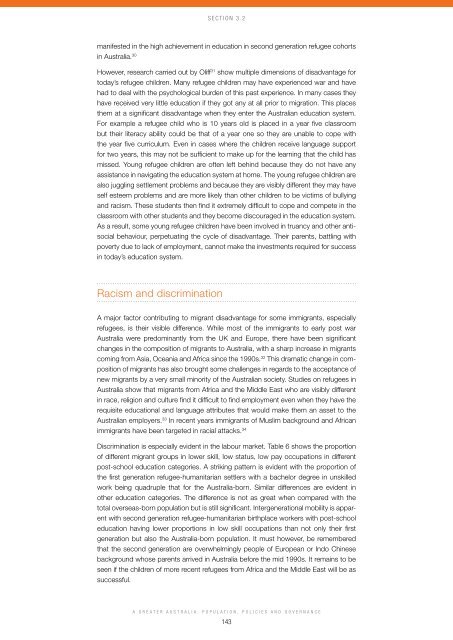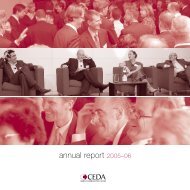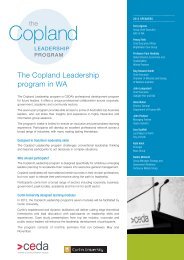A Greater Australia: Population, policies and governance - CEDA
A Greater Australia: Population, policies and governance - CEDA
A Greater Australia: Population, policies and governance - CEDA
- No tags were found...
Create successful ePaper yourself
Turn your PDF publications into a flip-book with our unique Google optimized e-Paper software.
Section 3.2manifested in the high achievement in education in second generation refugee cohortsin <strong>Australia</strong>. 30However, research carried out by Oliff 31 show multiple dimensions of disadvantage fortoday’s refugee children. Many refugee children may have experienced war <strong>and</strong> havehad to deal with the psychological burden of this past experience. In many cases theyhave received very little education if they got any at all prior to migration. This placesthem at a significant disadvantage when they enter the <strong>Australia</strong>n education system.For example a refugee child who is 10 years old is placed in a year five classroombut their literacy ability could be that of a year one so they are unable to cope withthe year five curriculum. Even in cases where the children receive language supportfor two years, this may not be sufficient to make up for the learning that the child hasmissed. Young refugee children are often left behind because they do not have anyassistance in navigating the education system at home. The young refugee children arealso juggling settlement problems <strong>and</strong> because they are visibly different they may haveself esteem problems <strong>and</strong> are more likely than other children to be victims of bullying<strong>and</strong> racism. These students then find it extremely difficult to cope <strong>and</strong> compete in theclassroom with other students <strong>and</strong> they become discouraged in the education system.As a result, some young refugee children have been involved in truancy <strong>and</strong> other antisocialbehaviour, perpetuating the cycle of disadvantage. Their parents, battling withpoverty due to lack of employment, cannot make the investments required for successin today’s education system.Racism <strong>and</strong> discriminationA major factor contributing to migrant disadvantage for some immigrants, especiallyrefugees, is their visible difference. While most of the immigrants to early post war<strong>Australia</strong> were predominantly from the UK <strong>and</strong> Europe, there have been significantchanges in the composition of migrants to <strong>Australia</strong>, with a sharp increase in migrantscoming from Asia, Oceania <strong>and</strong> Africa since the 1990s. 32 This dramatic change in compositionof migrants has also brought some challenges in regards to the acceptance ofnew migrants by a very small minority of the <strong>Australia</strong>n society. Studies on refugees in<strong>Australia</strong> show that migrants from Africa <strong>and</strong> the Middle East who are visibly differentin race, religion <strong>and</strong> culture find it difficult to find employment even when they have therequisite educational <strong>and</strong> language attributes that would make them an asset to the<strong>Australia</strong>n employers. 33 In recent years immigrants of Muslim background <strong>and</strong> Africanimmigrants have been targeted in racial attacks. 34Discrimination is especially evident in the labour market. Table 6 shows the proportionof different migrant groups in lower skill, low status, low pay occupations in differentpost-school education categories. A striking pattern is evident with the proportion ofthe first generation refugee-humanitarian settlers with a bachelor degree in unskilledwork being quadruple that for the <strong>Australia</strong>-born. Similar differences are evident inother education categories. The difference is not as great when compared with thetotal overseas-born population but is still significant. Intergenerational mobility is apparentwith second generation refugee-humanitarian birthplace workers with post-schooleducation having lower proportions in low skill occupations than not only their firstgeneration but also the <strong>Australia</strong>-born population. It must however, be rememberedthat the second generation are overwhelmingly people of European or Indo Chinesebackground whose parents arrived in <strong>Australia</strong> before the mid 1990s. It remains to beseen if the children of more recent refugees from Africa <strong>and</strong> the Middle East will be assuccessful.A <strong>Greater</strong> <strong>Australia</strong>: <strong>Population</strong>, Policies <strong>and</strong> Governance143





